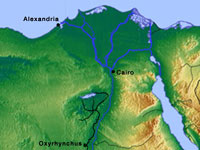
Oxyrhynchus lies about 100 miles southwest of Cairo, beneath the modern
village of el-Bahnasa.
|
Who's ever heard of Oxyrhynchus? You're forgiven if you haven't, because this
ancient city still lies buried beneath Egypt's desert sands. Yet scholars
actually know heaps about this once-thriving cultural oasis, which during the
Greek and Roman occupations (332 B.C. - A.D. 641) became the third-largest city
in Egypt. How do they know so much? Because of the city's garbage dumps, specifically the thousands of
fragments of ancient writing on papyrus that were preserved there until British
archeologists dug them up in the late 19th century. Here, see a selection of papyrus
writings that have revealed a city and a time.—Rima Chaddha


|
|
The Gospel of Thomas (3rd century)
"Know
what is in front of your face, and what is hidden from you will be disclosed to
you. For there is nothing hidden that will not be revealed."—Jesus
Christ, 5th saying
With a stroke of beginners' luck, one of the British team's earliest finds in
Oxyrhynchus was also one of its most important. The men stumbled upon
fragments of logia, or sayings of Jesus Christ, which until their discovery
had been lost for nearly two millennia. The publication and sale of these
lost sayings allowed the team to generate funding for additional excavations at Oxyrhynchus.
|
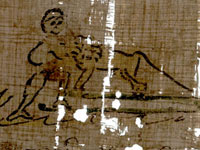

|
|
Adventures of Heracles (3rd century)
"[Heracles] built up the one entrance and came in upon the beast through the
other, and putting his arm round its neck held it tight till he had choked
it...."—Apollodorus, The Library, Book II
While it might look like part of an ancient comic strip, this colored drawing
comes from what was likely a schoolboy's reading assignment. The fragment and
its accompanying text illustrate the first of the 12 famous labors plaguing the
demigod Heracles: slaying the supposedly unconquerable Nemean Lion and bringing
back its skin.
|


|
|
"The Tracking Satyrs" (c. 2nd century)
"What kind of a way to hunt is that, bent over and leaning down to the ground?
... You're lying there like a hedgehog fallen on the ground, or an ape sticking
his head forward and having a temper tantrum.... Where on earth did you learn
this, and how?"—Silenus to one of his satyr children, Ichneutae
This snippet of a once-lost comedic satyr play turned heads when scholars
translated it in the early 20th century. The author, it turns out, was famed
Greek tragedian Sophocles, who until a century ago had a reputation among
classicists for being too serious to venture into this genre of light-hearted
humor.
|
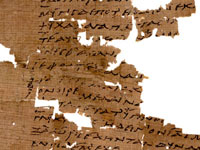

|
|
Lost poetry of Sappho (3rd century)
"My
heart's grown heavy, my knees will not support me /.... This state I oft
bemoan; but what's to do? / Not to grow old, being human, there's no
way."—Sappho, Book IV
Famous for her ability to capture human emotion, Greek lyric poetess Sappho
published nine volumes of poetry in her lifetime, all of which were lost until
excavators discovered a few fragments among the Oxyrhynchus papyri. Until the find, Sappho's influential works were known only through brief
quotations used by later authors.
|
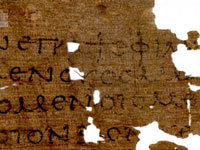

|
|
How to flatter a woman (2nd century)
"To an ugly woman, say that she is `fascinating,' and to a middle-aged one,
that she is a `wild pigeon.'"—Philaenis of Samos, The Art of
Love
When magical spells or advice from the local oracle failed to do the trick, the
upper-class citizens of Roman Oxyrhynchus could always improve their romantic
luck through handbooks like this one. Regarded as an authoritative guide to
passion in the ancient world—complete with advice on aphrodisiacs and
sexual positions—this is one of the few technical works of the time
believed to have been written by a woman.
|
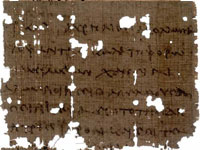

|
|
Letter to a priestess (after A.D. 217)
"You
will do well to go ... to the temple of Demeter to perform the usual sacrifices
on behalf of our lords and emperors and their victory and the rise of the Nile
and the increase of the crops and the healthy balance of the
climate."—Marcus Aurelius Apollonius, priest
This brief letter from a priest to a priestess provides a revealing look at the
multiculturalism of Greco-Roman Egypt. The temple and its deity Demeter, the
goddess of agriculture, are Greek; the "lords and emperors and their victory"
are Roman; and the sacrifice for the annual flooding of the Nile is a decidedly
Egyptian need.
|
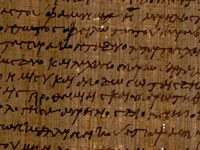

|
|
Acknowledgment of indebtedness (A.D. 223-224)
"If I fail to repay as is set down in this bond I will pay you interest at 50
percent, you retaining the right of execution on me and my possessions of any
and every sort."—Aurelius Papontos
Like most of the citizens of Oxyrhynchus, this man was illiterate and had to
hire a scribe to write this legal agreement. The employment of scribes had a major
influence upon the tone of all personal documents in Oxyrhynchus, even private
letters, which tended to be very formal and impersonal.
|
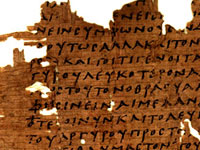

|
|
Against philosophers (2nd/3rd century)
"...[W]hat could be whiter than silver? Yet still Thrasyalces says that silver
is black. So, when even the whiteness of silver is on the doubtful side, what
wonder that men differ when they consult about peace and war, about alliance
and revenue and expenditure and things like that?"—Anonymous
Probably the work of a philistine or a rival philosopher, this fragment further
illustrates the assimilation of Greek life into ancient Oxyrhynchus as well as
its prevalence through the Roman-Egyptian period. The writer goes on to say
that madmen locked in a house would behave more peaceably than a group of
philosophers confined in their place.
|
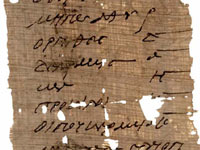

|
|
Items for a sacrifice (c. 4th century)
"Hens, 4; piglet, 1; eggs, 8; cones, 8; jars of wine, 2; honey, milk, olive
oil, oil of sesame, a small measure of each; flower garlands, 8."—A list
of items for a sacrifice
Addressed to a beneficiarius (a Roman soldier on special assignment), this list
is typical of the items used in religious sacrifice. Written in the Egyptian
month of Hathyr, which corresponds largely to our modern November, these items
were probably requested in relation to an important winter festival.
|
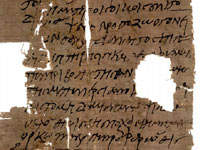

|
|
Oath to care for the trees (A.D. 323)
"We agree, swearing the august divine oath by our lords the unconquered kings,
that we shall take every care of and do every service to and regularly irrigate
the persea tree ... for it is to propagate and to grow always."—A sworn
declaration from a group of men to Roman-Egyptian magistrate Dioscourides
Despite being employed under Roman administration in the fourth century,
Oxyrhynchus officials continued the ancient Greek practice of commissioning
contractors to plant and care for trees, generally in the city streets.
Religiously, the persea was considered the "tree of life."
|
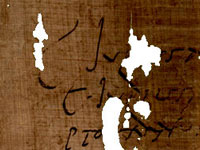

|
|
A Latin will (2nd century)
"[M]y
sons and Claudia Techosis ... mother of my children, shall be my only heirs to
all my property in equal shares"—The last will and testament of C. Iulius
Diogenes
Even as the Romans came to power in Egypt in 30 B.C., most Oxyrhynchus
documents, whether official, religious, literary, or private, were still
written in Greek. But the use of Latin is not the only thing that makes this
will stand out. Few papyrus fragments of Roman wills exist today because
most wills were engraved on wax tablets; in fact, this document is likely a
copy of an official wax will.
|
|
|













